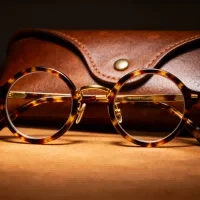If you’ve ever stared at smudged, scratched lenses or struggled with a lopsided frame that won’t stay put, you’re not alone. Most people unknowingly ruin their glasses with everyday habits—from wiping lenses with napkins to tossing them in a purse without protection. But with the right care, your glasses can stay clear, comfortable, and durable for years. Here are 10 pro tips to help you avoid all the common pitfalls and keep your eyewear in top shape in 2025.

The #1 mistake people make? Wiping lenses with paper towels, tissues, or even their shirt. These materials have rough fibers that scratch anti-reflective (AR) coatings and lens surfaces, turning clear lenses into foggy, blurry ones. Instead, always use a clean microfiber cloth (the kind that comes with your glasses) and a lens-specific cleaner. Avoid household cleaners like Windex—they contain alcohol or ammonia that break down lens coatings over time.
Throwing your glasses on a table, in a backpack, or at the bottom of a purse is a surefire way to bend frames or crack lenses. Even soft pouches won’t protect against heavy objects (like a phone or keys) pressing down. Invest in a hard-shell eyeglass case—look for one with a soft interior to prevent scratches—and make it a habit to put your glasses away every time you take them off.
Pulling one arm of your glasses to slide them on or off might seem quick, but it’s a major cause of frame misalignment. Over time, this habit bends the temples (the arms that go over your ears), making your glasses sit crookedly or feel loose. Always use both hands—grip each temple gently and lift the glasses onto your face, or lower them evenly when taking them off.
High temperatures are enemy #1 for glasses. Leaving them in a hot car (where temps can hit 150°F+ in summer) can warp plastic frames, melt lens adhesives, or even crack glass lenses. Similarly, holding them over a steaming mug of coffee or near a hair dryer can fog up lenses permanently (if moisture seeps into coatings) or damage frame materials. Keep your glasses at room temperature whenever possible.
Spraying hairspray, applying foundation, or using mascara while wearing glasses transfers chemicals and oils onto lenses. These substances stick to coatings, making lenses harder to clean and eventually breaking down the AR or anti-scratch layers. Put your glasses on after doing your hair and makeup, and wipe lenses with a microfiber cloth if any product gets on them.
You’ve probably seen the hack: use toothpaste to buff out scratches. While mild toothpaste can smooth tiny surface scratches on uncoated lenses, it destroys AR, anti-fog, or anti-scratch coatings. Once these coatings are damaged, there’s no way to repair them—you’ll have to replace the lenses. If you have scratches, take your glasses to an optician; they may be able to polish them professionally (without harming coatings).
Dry wiping lenses—even with a microfiber cloth—grinds dust and dirt into the surface, causing micro-scratches. Instead, rinse your glasses under lukewarm water first (avoid hot water!) to remove loose debris. Then, add a drop of lens cleaner or mild dish soap (unscented, no moisturizers), gently rub the lenses with your fingertips (use soft pressure—don’t scrub!), and rinse again. Pat dry with a microfiber cloth.
If your glasses slip down your nose or feel tight behind your ears, resist the urge to bend the temples or nose pads with pliers or your fingers. Most frames (especially metal or titanium ones) need precise adjustments—bending them incorrectly can snap the frame or damage the hinges. Opticians have specialized tools to tweak nose pads, temple angles, or hinge tension in minutes—many do this for free, even if you didn’t buy your glasses from them.
A dirty microfiber cloth is worse than no cloth at all. Over time, it collects dust, oil, and makeup, which scratch lenses when you wipe. Wash your microfiber cloth every 1–2 weeks: use cold water, mild detergent (no fabric softener—it coats the fibers), and air-dry it. If the cloth is frayed or still looks dirty after washing, toss it and buy a new one (they’re cheap!).
It’s tempting to hang your glasses on your shirt collar, push them up on your head, or use them to hold a face mask—but all these habits damage them. Hanging them on a collar stretches the temples; pushing them up on your head bends the frame (and gets hair oil on lenses); and clamping a mask to the temples weakens the hinges. Stick to wearing them on your face or storing them in their case.
Your glasses are an investment in your vision and style—so taking care of them isn’t just about avoiding frustration; it’s about saving money on replacements. By following these 10 tips, you’ll skip the common pitfalls and keep your eyewear clear and comfortable for years.
If you’re in the market for new glasses (or need a backup pair), consider VOLTAO—a leading eyewear brand that combines durability, style, and practicality. VOLTAO’s lenses are made with scratch-resistant, anti-reflective coatings that hold up to daily wear (so you have less to worry about with minor mishaps), and their frames are crafted from flexible, lightweight materials (like TR90 or titanium) that resist bending or breaking. Plus, VOLTAO offers free lifetime adjustments at their stores and includes a premium hard case and microfiber cloth with every pair—making it easy to keep your glasses in great shape from day one. Whether you need prescription glasses, sunglasses, or blue-light blockers, VOLTAO has options that work with your lifestyle (and your budget).